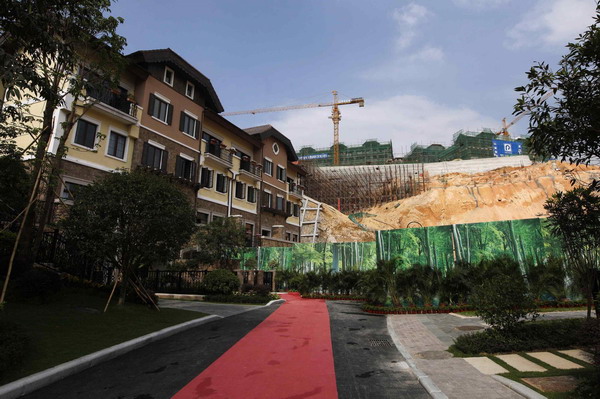Chinese replica Austrian village stirs up controversy
Updated: 2012-06-08 19:44
(Xinhua)
|
||||||||
HUIZHOU, Guangdong - A Chinese copy of a scenic town in Austria has shown great potential for business opportunities despite controversy over the project's alleged plagiarism.
 |
|
A general view of houses for sale at the replica village of Austria's UNESCO heritage site, Hallstatt, in China's southern city of Huizhou in Guangdong province June 1, 2012. [Photo/Agencies] |
Located in suburban Boluo county, Huizhou city in southern Guangdong province, the replica of the centuries-old Hallstatt has been open to visitors only a dozen days, yet many of the homes in the residential complex have already been snapped up.
Of the 400 villas constructed in the 20,000-square-meter European-style town, 150 have been sold, for an average price of 9,000 yuan ($1,425), double the average housing price in the county seat of Boluo.
More small and medium-sized apartments will follow in the town in coming years, according to Shi Lingyun, executive deputy manager-general of the Huizhou branch of the project's developer, the China Minmetals Corporation.
Meanwhile, the firm has decided to take a step further and build the town, initially conceived as a straightforward medium and high-end housing complex, into a commercial district and tourism attraction.
Some stores, including wedding photography studios and bars, have agreed to enter into the town's central area -- in which assisted living facilities had originally been planned -- and more "mature brands" will be brought in, said Shi.
Shi also noted possibilities of turning the town into a new tourism destination in the Pearl River Delta, a world-renowned manufacturing hub.
The 6-billion-yuan replica, regarded as a bold example of China's knock-off culture, has won instant fame as it has drawn both wows and discontent at home and abroad after being announced a year ago. That chatter seems to have proven a positive PR exercise for the people behind it.
The controversy has also benefited Hallstatt, which was listed as a world natural heritage site by UNESCO in 1997.
In 2005, only 47 Chinese people visited the lake-side Austrian village.The number skyrocketed to 8,700 six years later, Martin Woller, an official with the Austrian Consulate-General in Guangzhou, said when he and Hallstatt mayor Alexander Scheutz flew to China earlier this month to attend a ceremony for the project.
He said the surge in tourist numbers was "unexpected" and noted goings-on in Boluo county were Hallstatt's "best advertisement in China."
He said as Austrians, they are honored to have an Austrian-style town on the opposite side of the world. His tone was echoed by the mayor in an ebullient speech delivered at the ceremony.
Controversy remains
Shi said he would no longer worry about a lawsuit over infringement on intellectual property rights that critics had expected.
"The Austrian delegation has given the nod to the project. They see it as unique, a part of the cultural exchange between the two countries," he explained.
Some analysts view Austria's approval of the complex as predictable, given that China has become the country's second-largest trade partner.
Shi objected that the project is not sheer plagiarism of Hallstatt and instead it incorporates styles from a number of Austrian towns.
However, his comments can not convince everyone.
"The place looks very 'European' and impressive. But it's not good enough as a replica of a UNESCO-listed world heritage site," Li Ting, a local resident, told Xinhua during her tour of the town.
"It's understandable to learn from foreign architecture, but we should show respect to our own history," said a senior Chinese architect who wished to remain anonymous.
Ma Yansong, another celebrated architect, also said a copy-cat housing scheme is not acceptable, arguing, "Only when we get down to studying our own culture, will there be something 'original'."
Shi admitted the success of the project came "by chance."
"We chose Austria simply because China already has British style, American style, French style, Spanish style, Italian style and Austrian style. To be honest, we didn't expect so much aftermath."
Nevertheless, he said he believed the developer would not undertake similar projects.
"Like ours, many Chinese real estate projects in China aim to open a window for consumers to see the world. In the future, maybe we should create more housing projects featuring the Chinese architectural style," Shi added.

 Relief reaches isolated village
Relief reaches isolated village
 Rainfall poses new threats to quake-hit region
Rainfall poses new threats to quake-hit region
 Funerals begin for Boston bombing victims
Funerals begin for Boston bombing victims
 Quake takeaway from China's Air Force
Quake takeaway from China's Air Force
 Obama celebrates young inventors at science fair
Obama celebrates young inventors at science fair
 Earth Day marked around the world
Earth Day marked around the world
 Volunteer team helping students find sense of normalcy
Volunteer team helping students find sense of normalcy
 Ethnic groups quick to join rescue efforts
Ethnic groups quick to join rescue efforts
Most Viewed
Editor's Picks

|

|

|

|

|

|
Today's Top News
Health new priority for quake zone
Xi meets US top military officer
Japan's boats driven out of Diaoyu
China mulls online shopping legislation
Bird flu death toll rises to 22
Putin appoints new ambassador to China
Japanese ships blocked from Diaoyu Islands
Inspired by Guan, more Chinese pick up golf
US Weekly

|

|






